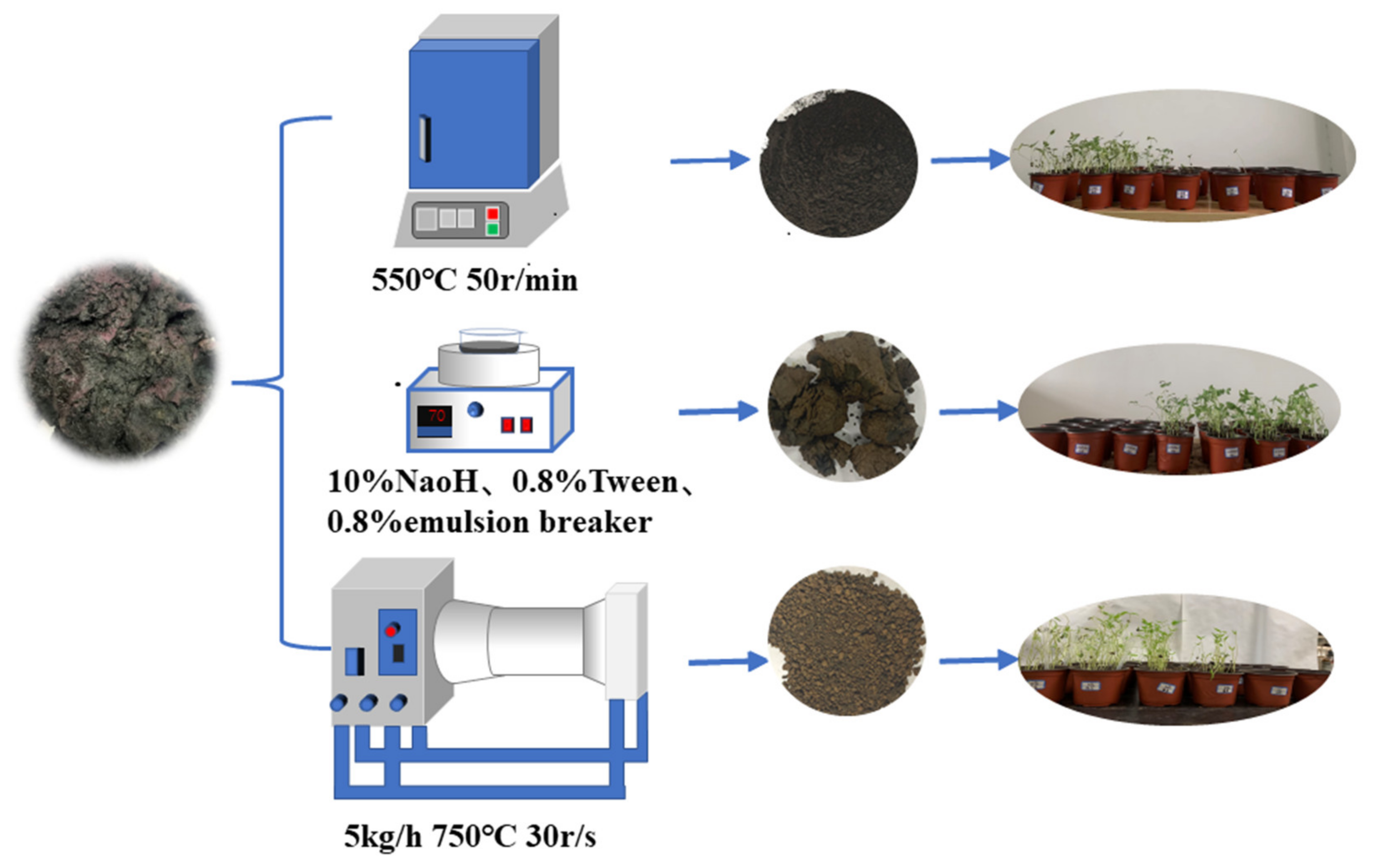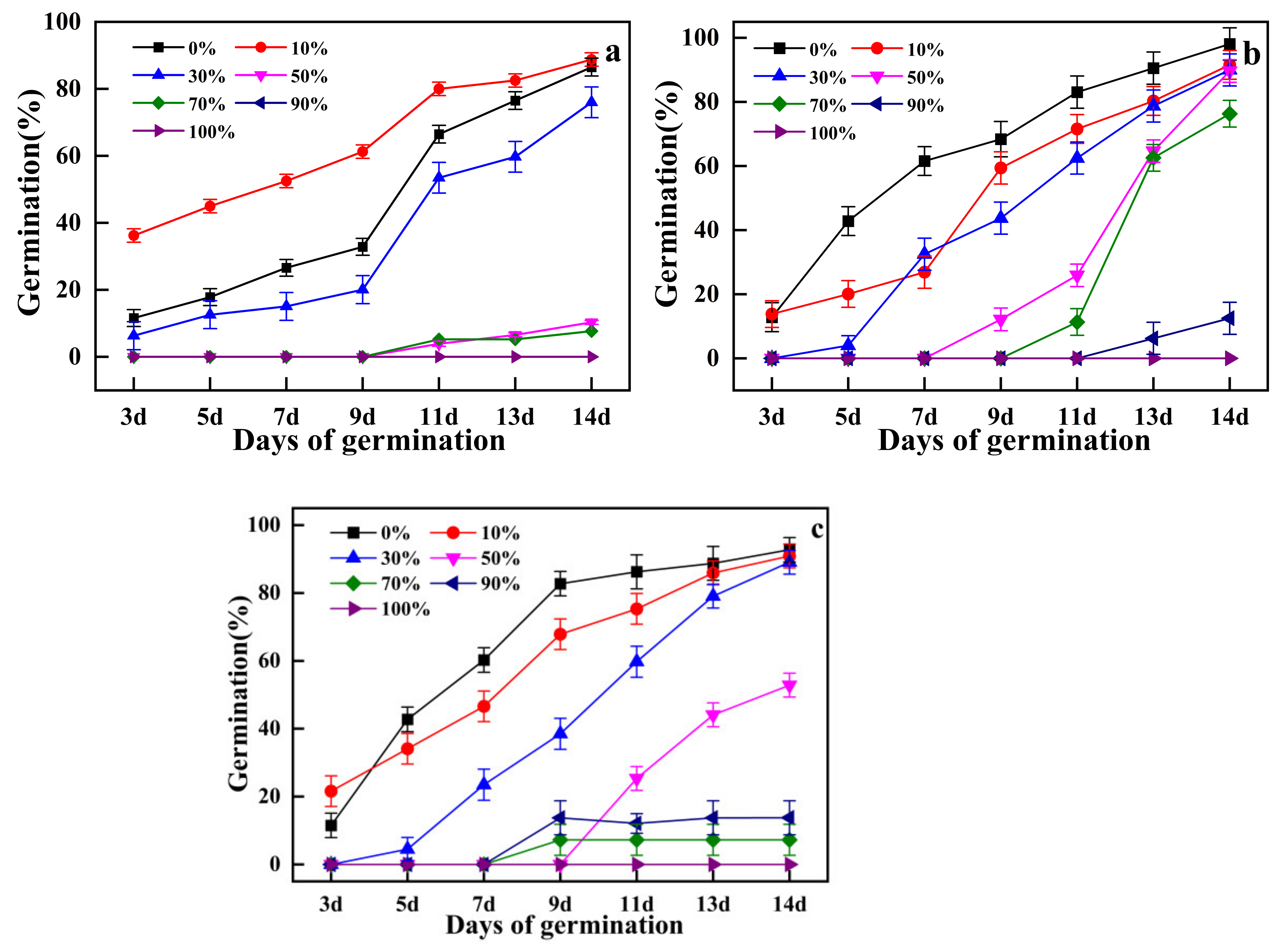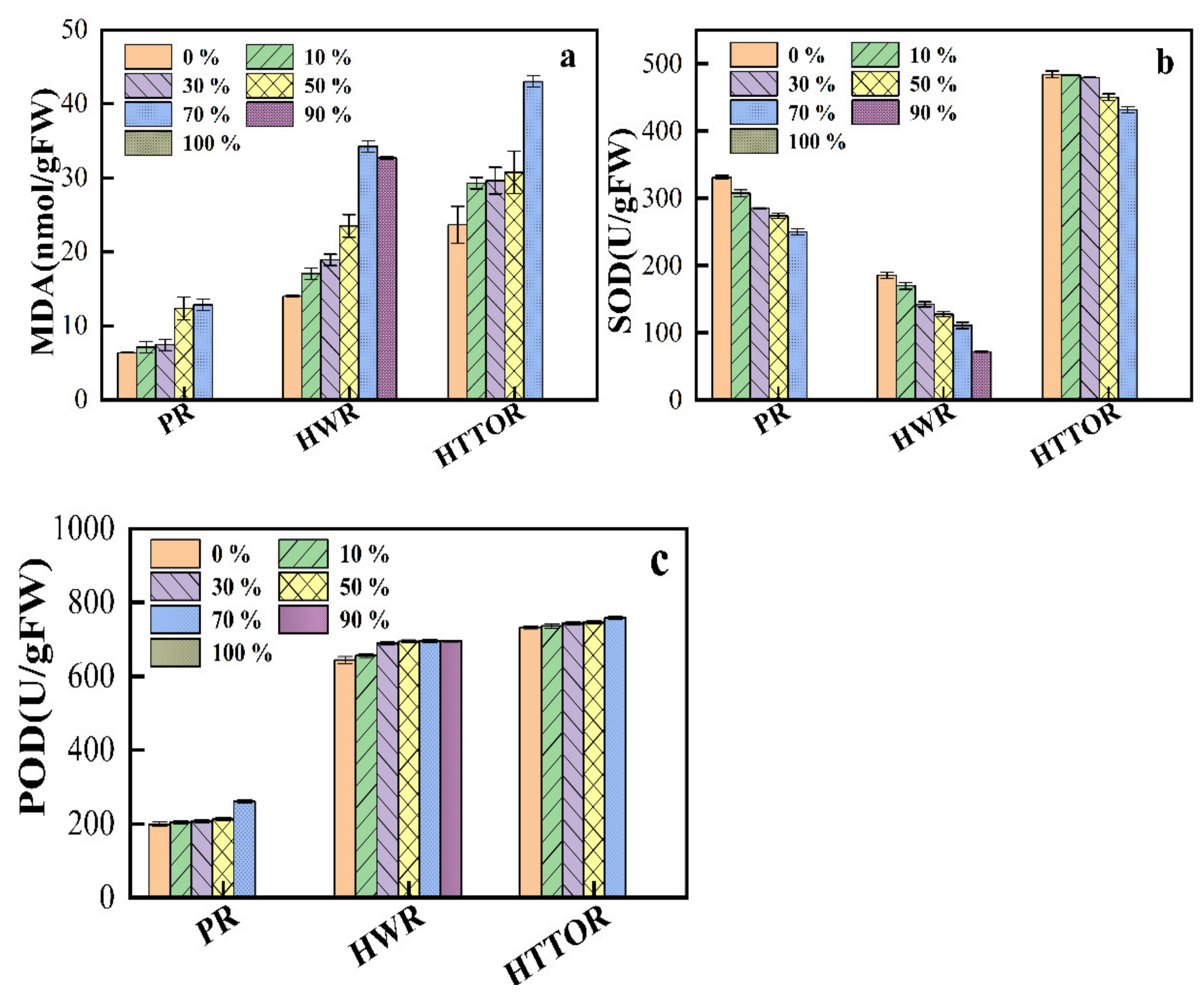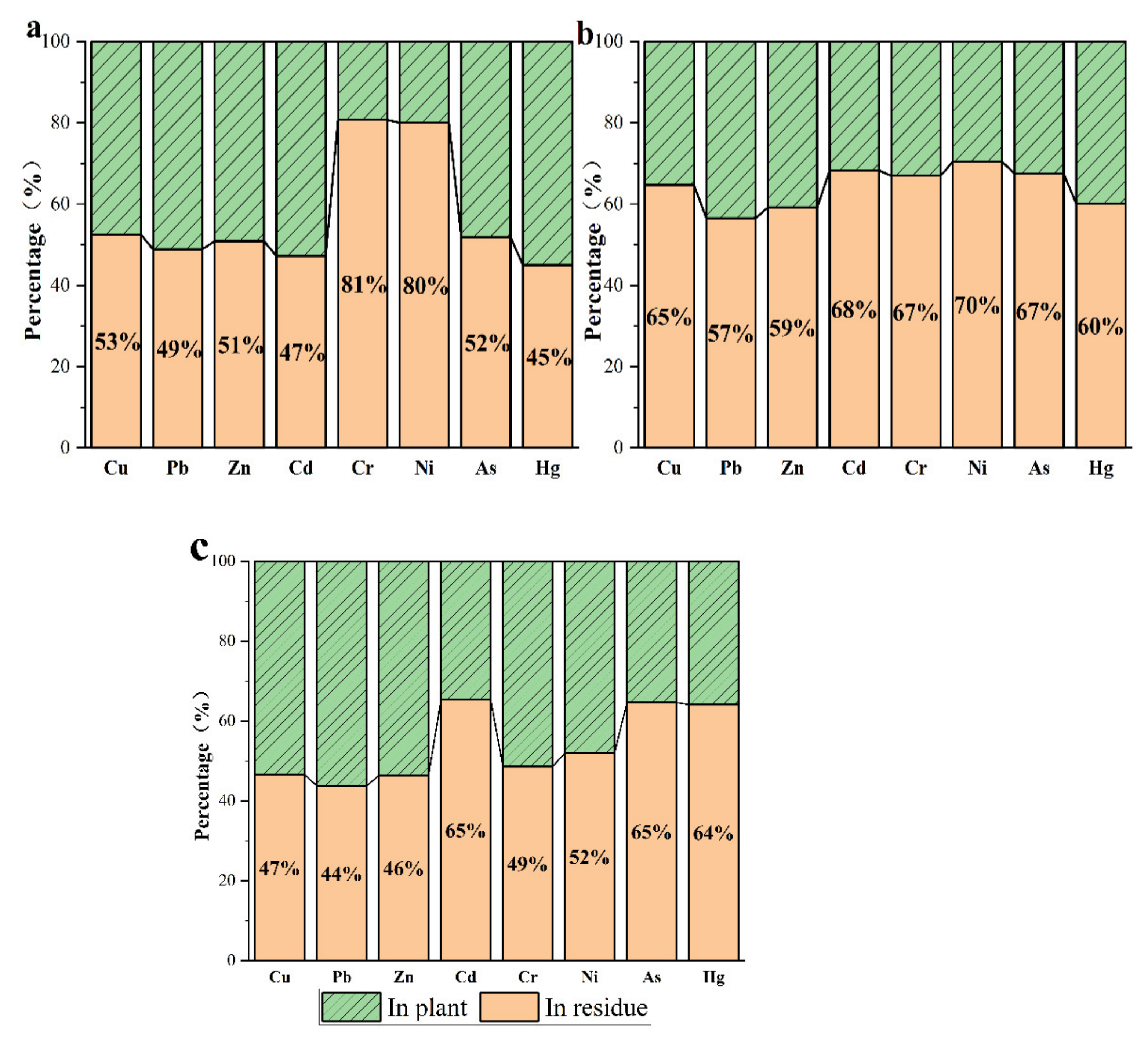Effects of Different Heat Treatment Methods on Organic Pollutants and Heavy Metal Content in Oil Sludge Waste and Ecotoxicological Evaluation
Abstract
:1. Introduction
2. Materials and Methods
2.1. Raw Oily Sludge and Residue Preparation
2.2. Potted Plant Experiment
2.3. Analytical Methods
2.3.1. Detection of Heavy Metals and Organic Compounds in Heat Treatment Residues
2.3.2. Plant Activity Testing
3. Results and Discussion
3.1. Toxicants in Oily Sludge Heat Treatment Residue
3.1.1. Organic Compounds in Heat Treatment Residues
3.1.2. Heavy Metal Contents in Heat Treatment Residues
3.2. Plant Growth
3.2.1. Effects of Heat Treatment Residues on the Germination Rates of Mung Beans
3.2.2. Analysis of MDA and Enzymatic Activity of Mung Beans after Heat Treatment Residue Cultivation
3.3. Analysis of Heavy Metal Contents in Residues before and after Planting
4. Conclusions
Author Contributions
Funding
Institutional Review Board Statement
Informed Consent Statement
Data Availability Statement
Conflicts of Interest
References
- Johnson, O.A.; Affam, A.C. Petroleum sludge treatment and disposal: A review. Environ. Eng. Res. 2018, 24, 191–201. [Google Scholar] [CrossRef]
- Rocha, O.; Dantas, R.F.; Duarte, M.; Duarte, M.; Silva, V. Oil sludge treatment by photocatalysis applying black and white light. Chem. Eng. J. 2010, 157, 80–85. [Google Scholar] [CrossRef]
- Mrayyan, B.; Battikhi, M.N. Biodegradation of total organic carbons (TOC) in Jordanian petroleum sludge. J. Hazard. Mater. 2005, 120, 127–134. [Google Scholar] [CrossRef] [PubMed]
- Wang, Z.; Gong, Z.; Wang, Z.; Li, X.; Chu, Z. Application and Development of Pyrolysis Technology in Petroleum Oily Sludge Treatment. Environ. Eng. Res. 2020, 26, 190460. [Google Scholar] [CrossRef]
- Zhou, S.; Li, S.; Gao, X.; Qian, Y.; Li, L.; Chen, X. Combustion behavior and thermal stability of ethylene-vinyl acetate composites based on CaCO3-containing oil sludge and carbon black. J. Therm. Anal. 2018, 136, 1135–1145. [Google Scholar] [CrossRef]
- Takaya, C.A.; Fletcher, L.A.; Singh, S.; Okwuosa, U.C.; Ross, A.B. Recovery of phosphate with chemically modified biochars. J. Environ. Chem. Eng. 2016, 4, 1156–1165. [Google Scholar] [CrossRef]
- Yan, P.; Lu, M.; Yang, Q.; Zhang, H.L.; Zhang, Z.Z.; Chen, R. Oil recovery from refinery oily sludge using a rhamnolipid biosurfactant-producing Pseudomonas. Bioresour. Technol. 2012, 116, 24–28. [Google Scholar] [CrossRef]
- Deng, S.; Ke, T.; Wu, Y.; Zhang, C.; Hu, Z.; Yin, H.; Guo, L.; Chen, L.; Zhang, D. Heavy Metal Exposure Alters the Uptake Behavior of 16 Priority Polycyclic Aromatic Hydrocarbons (PAHs) by Pak Choi (Brassica chinensis L.). Environ. Sci. Technol. 2018, 52, 13457–13468. [Google Scholar] [CrossRef]
- Khudur, L.S.; Gleeson, D.B.; Ryan, M.H.; Shahsavari, E.; Haleyur, N.; Nugegoda, D.; Ball, A.S. Implications of co-contamination with aged heavy metals and total petroleum hydrocarbons on natural attenuation and ecotoxicity in Australian soils. Env. Pollut. 2018, 243, 94–102. [Google Scholar] [CrossRef]
- Hu, G.; Li, J.; Zhang, X.; Li, Y. Investigation of waste biomass co-pyrolysis with petroleum sludge using a response surface methodology. J. Environ. Manag. 2017, 192, 234–242. [Google Scholar] [CrossRef]
- Liang, J.; Zhao, L.; Hou, W. Solid effect in chemical cleaning treatment of oily sludge. Colloids Surf. A Physicochem. Eng. Asp. 2017, 522, 38–42. [Google Scholar] [CrossRef]
- Ming, D.; Wang, X.; Fang, S.; Bo, Z.; Li, C.; Xiong, Y. Treatment of Daqing Oily Sludge by Thermochemical Cleaning Method. Colloids Surf. A Physicochem. Eng. Asp. 2018, 554, 272–278. [Google Scholar] [CrossRef]
- Senser, D.W.; Cundy, V.A. The combustion characteristics of selected chlorinater methanes in a flat flame environment. Chem. Eng. Commun. 1986, 40, 153–168. [Google Scholar] [CrossRef]
- Chen, C.; Li, S.; Yue, C.; Kruttschnitt, T.; Yao, Q. Lab-scale pyrolysis of oil sludge in continuous rotating reactor: Mass/energy balance and product analysis. Huagong Xuebao J. Chem. Ind. Eng. 2006, 57, 650–657. [Google Scholar]
- Muniz, P. Assessment of contamination by heavy metals and petroleum hydrocarbons in sediments of Montevideo Harbour (Uruguay). Environ. Int. 2004, 29, 1019–1028. [Google Scholar] [CrossRef]
- Oriomah, C.; Adelowo, O.O.; Adekanmbi, A.O. Bacteria from spent engine-oil-contaminated soils possess dual tolerance to hydrocarbon and heavy metals, and degrade spent oil in the presence of copper, lead, zinc and combinations thereof. Ann. Microbiol. 2014, 65, 207–215. [Google Scholar] [CrossRef]
- Tang, C.; Guan, J.; Xie, S. Study on Reutilization of Pyrolytic Residues of Oily Sludge. Int. J. Anal. Chem. 2020, 2020, 8858022. [Google Scholar] [CrossRef]
- Han, Z.; Wei, X.; Wan, D.; He, W.; Wang, X.; Xiong, Y. Effect of Molybdenum on Plant Physiology and Cadmium Uptake and Translocation in Rape (Brassica napus L.) under Different Levels of Cadmium Stress. Int. J. Environ. Res. Public Health 2020, 17, 2355. [Google Scholar] [CrossRef] [Green Version]
- Du, M.; Li, J.; Wang, F.; Li, X.; Yu, T.; Qu, C. The sludge-based adsorbent from oily sludge and sawdust: Preparation and optimization. Environ. Technol. 2020, 5, 3164–3177. [Google Scholar] [CrossRef]
- Li, H.; Martin, F.L.; Jones, K.C.; Zhang, D. Interrogating the Transient Selectivity of Bacterial Chemotaxis-Driven Affinity and Accumulation of Carbonaceous Substances via Raman Microspectroscopy. Front. Microbiol. 2019, 10, 2215. [Google Scholar] [CrossRef]
- Gascó, G.; Méndez, A. Sorption of Ca2+, Mg2+, Na+ and K+ by clay minerals. Desalination 2005, 182, 333–338. [Google Scholar] [CrossRef]
- Méndez, A.; Gascó, G. Optimization of water desalination using carbon-based adsorbents. Desalination 2005, 183, 249–255. [Google Scholar] [CrossRef]
- Liu, S.H.; Zeng, G.M.; Niu, Q.Y.; Liu, Y.; Zhou, L.; Jiang, L.H.; Tan, X.F.; Xu, P.; Zhang, C.; Cheng, M. Bioremediation mechanisms of combined pollution of PAHs and heavy metals by bacteria and fungi: A mini review. Bioresour. Technol. 2017, 224, 25–33. [Google Scholar] [CrossRef] [PubMed]
- Cristaldi, A.; Conti, G.O.; Jho, E.H.; Zuccarello, P.; Grasso, A.; Copat, C.; Ferrante, M. Phytoremediation of contaminated soils by heavy metals and PAHs. A brief review. Environ. Technol. Innov. 2017, 8, 309–326. [Google Scholar] [CrossRef]
- Fan, X.; Jiao, X.; Liu, J.; Jia, M.; Blanchard, C.; Zhou, Z. Characterizing the volatile compounds of different sorghum cultivars by both GC-MS and HS-GC-IMS. Food Res. Int. 2021, 140, 109975. [Google Scholar] [CrossRef]
- Gonzaga, M.I.S.; Matias, M.; Andrade, K.R.; Jesus, A.N.; Cunha, G.D.C.; Andrade, R.S.; Santos, J.C.J. Aged biochar changed copper availability and distribution among soil fractions and influenced corn seed germination in a copper-contaminated soil. Chemosphere 2020, 240, 124828. [Google Scholar] [CrossRef]
- Ratajczak, A.; Geißdörfer, W.; Hillen, W. Expression of Alkane Hydroxylase fromAcinetobacter sp. Strain ADP1 Is Induced by a Broad Range of n- Alkanes and Requires the Transcriptional Activator AlkR. J. Bacteriol. 1998, 180, 5822–5827. [Google Scholar] [CrossRef] [Green Version]
- Zhang, D.; He, Y.; Wang, Y.; Wang, H.; Wu, L.; Aries, E.; Huang, W.E. Whole-cell bacterial bioreporter for actively searching and sensing of alkanes and oil spills. Microb. Biotechnol. 2011, 5, 87–97. [Google Scholar] [CrossRef] [Green Version]
- Li, H.; Yang, Y.; Zhang, D.; Li, Y.; Jones, K.C. Evaluating the simulated toxicities of metal mixtures and hydrocarbons using the alkane degrading bioreporter Acinetobacter baylyi ADPWH_recA. J. Hazard. Mater. 2021, 419, 126471. [Google Scholar] [CrossRef]
- Agnello, A.C.; Bagard, M.; Hullebusch, E.; Esposito, G.; Huguenot, D. Comparative bioremediation of heavy metals and petroleum hydrocarbons co-contaminated soil by natural attenuation, phytoremediation, bioaugmentation and bioaugmentation-assisted phytoremediation. Sci. Total Environ. 2016, 563, 693–703. [Google Scholar] [CrossRef]
- Ningbo, G.; Xiao, W.; Cui, Q.; Chunfei, W. Study of oily sludge pyrolysis combined with fine particle removal using a ceramic membrane in a fixed-bed reactor. Chem. Eng. Processing 2018, 128, 276–281. [Google Scholar] [CrossRef]
- Thomas, C.C.; Nsonwu-Anyanwu, A.C.; Usoro, C.A.O.; Agoro, E.S.; Idenyi, A.N. Hepato-renal toxicities associated with heavy metal contamination of water sources among residents of an oil contaminated area in Nigeria. Ecotoxicol. Environ. Saf. 2021, 212, 111988. [Google Scholar] [CrossRef] [PubMed]
- Visca, P.; Imperi, F.; Lamont, I.L. Pyoverdine siderophores: From biogenesis to biosignificance. Trends Microbiol. 2007, 15, 22–30. [Google Scholar] [CrossRef] [PubMed]
- Ebokaiwe, A.P.; Adedara, I.A.; Owoeye, O.; Farombi, E.O. Neurotoxicity of Nigerian bonny light crude oil in rats. Drug Chem. Toxicol. 2013, 36, 187–195. [Google Scholar] [CrossRef] [PubMed]
- Onyejekwe, I.M.; Osuji, L.C.; Nwaichi, E.O.; Bosah, I. Accumulation of Heavy Metal in the Seeds of Zea mays L. from Crude Oil Impacted Soils in Kom-Kom, Rivers State, Nigeria. J. Sci. Res. Rep. 2019, 25, 1–8. [Google Scholar] [CrossRef]
- Besser, J.M.; Brumbaugh, W.G.; Allert, A.L.; Poulton, B.C.; Schmitt, C.J.; Ingersoll, C.G. Ecological impacts of lead mining on Ozark streams: Toxicity of sediment and pore water. Ecotoxicol. Environ. Saf. 2009, 72, 516–526. [Google Scholar] [CrossRef]
- Zhang, H.; Gao, Z.; Liu, Y.; Ran, C.; Mao, X.; Kang, Q.; Ao, W.; Fu, J.; Li, J.; Liu, G. Microwave-assisted pyrolysis of textile dyeing sludge, and migration and distribution of heavy metals. J. Hazard. Mater. 2018, 355, 128–135. [Google Scholar] [CrossRef]
- Rusin, M.; Gospodarek, J.; Barczyk, G.; Nadgórska-Socha, A. Antioxidant responses of Triticum aestivum plants to petroleum-derived substances. Ecotoxicology 2018, 27, 1353–1367. [Google Scholar] [CrossRef] [Green Version]
- Hasegawa, R.; Hirata-Koizumi, M.; Hamamura, M.; Furukawa, H.; Fukuda, N.; Ito, Y.; Wako, Y.; Yamashita, K.; Takahashi, M.; Kamata, E. Higher susceptibility of newborn rats to 2-tert-butylphenol and 2,4-di-tert-butylphenol toxicity as compared with young rats. Toxicol. Lett. 2007, 172, S210–S211. [Google Scholar] [CrossRef]
- Vig, K.; Megharaj, M.; Sethunathan, N. Bioavailability and toxicity of cadmium to microorganisms and their activities in soil: A review. Adv. Environ. Res. 2004, 8, 121–135. [Google Scholar] [CrossRef]
- Montuelle, B.; Latour, X.; Volat, B.; Gounot, A.M. Toxicity of heavy metals to bacteria in sediments. Bull. Environ. Contam. Toxicol. 1994, 53, 753. [Google Scholar] [CrossRef] [PubMed]
- Tong, S.; Schirnding, V.; Yasmin, E. Environmental lead exposure: A public health problem of global dimensions. Bull. World Health Organ. 2000, 21, 659–686. [Google Scholar] [CrossRef] [Green Version]





| Sampling Volume | Temperature (°C) | Rotating Speed | Medicament | |
|---|---|---|---|---|
| Pyrolysis | 500 g | 500 | 50 r/min | __ |
| Thermal wash | 200 g | 70 | __ | Tween80(a surfactant); emulsion breaker |
| High-temperature oxidation | 500 g | 750 | 30 r/s | __ |
| Oil Content (%) | Water Content (%) | Solid Content (%) | |
|---|---|---|---|
| Raw sludge | 17.86 | 18.13 | 64.01 |
| Pyrolytic residue | 4.01 | 16.38 | 79.61 |
| Thermal-washing residue | 13.23 | 30.89 | 55.88 |
| High-temperature oxidation residue | 0.50 | 0.51 | 98.99 |
| Content | 0% | 10% | 30% | 50% | 70% | 90% | 100% |
|---|---|---|---|---|---|---|---|
| Residue (g) | 0 | 50 | 150 | 250 | 350 | 450 | 500 |
| Soil nutrients (g) | 500 | 450 | 350 | 250 | 150 | 50 | 0 |
Publisher’s Note: MDPI stays neutral with regard to jurisdictional claims in published maps and institutional affiliations. |
© 2022 by the authors. Licensee MDPI, Basel, Switzerland. This article is an open access article distributed under the terms and conditions of the Creative Commons Attribution (CC BY) license (https://creativecommons.org/licenses/by/4.0/).
Share and Cite
Sun, X.; Yu, T.; Huang, Y.; Xue, M.; Qu, C.; Yang, P.; Zhang, X.; Yang, B.; Li, J. Effects of Different Heat Treatment Methods on Organic Pollutants and Heavy Metal Content in Oil Sludge Waste and Ecotoxicological Evaluation. Appl. Sci. 2022, 12, 3609. https://doi.org/10.3390/app12073609
Sun X, Yu T, Huang Y, Xue M, Qu C, Yang P, Zhang X, Yang B, Li J. Effects of Different Heat Treatment Methods on Organic Pollutants and Heavy Metal Content in Oil Sludge Waste and Ecotoxicological Evaluation. Applied Sciences. 2022; 12(7):3609. https://doi.org/10.3390/app12073609
Chicago/Turabian StyleSun, Xuan, Tao Yu, Yi Huang, Ming Xue, Chengtun Qu, Penghui Yang, Xiaofei Zhang, Bo Yang, and Jinling Li. 2022. "Effects of Different Heat Treatment Methods on Organic Pollutants and Heavy Metal Content in Oil Sludge Waste and Ecotoxicological Evaluation" Applied Sciences 12, no. 7: 3609. https://doi.org/10.3390/app12073609
APA StyleSun, X., Yu, T., Huang, Y., Xue, M., Qu, C., Yang, P., Zhang, X., Yang, B., & Li, J. (2022). Effects of Different Heat Treatment Methods on Organic Pollutants and Heavy Metal Content in Oil Sludge Waste and Ecotoxicological Evaluation. Applied Sciences, 12(7), 3609. https://doi.org/10.3390/app12073609






